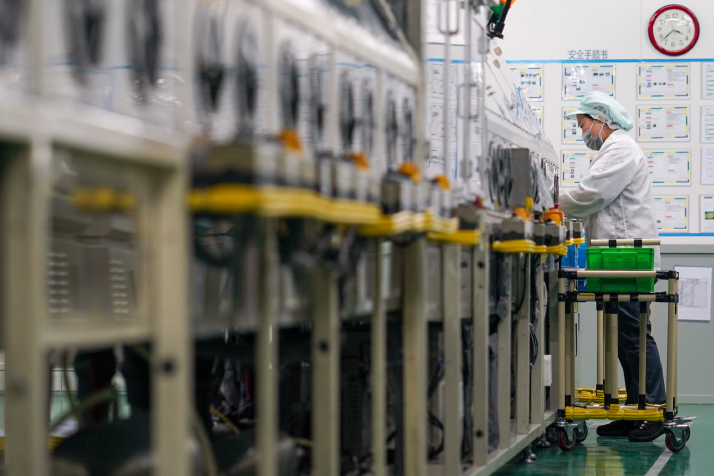| Business |
| China seeks closer cooperation in global value chain restructuring | |
|
|
 A battery assembly line at Panasonic Energy (Wuxi) Co. Ltd. in Wuxi, Jiangsu Province, on July 5, 2022 (XINHUA)
Is China losing its status as the "workshop of the world," and will it be replaced by countries such as Viet Nam and India? Some say they already have abundant examples to support this argument. For example, U.S. semiconductor giant Intel is to invest more than $7 billion to build a factory in Malaysia and Murata Manufacturing Co. Ltd. from Japan plans this year to establish a factory in Thailand that is of similar size to its current factory in Wuxi, Jiangsu Province in east China. Moreover, many multinational corporations reportedly have formulated "China Plus One" strategies, aimed at lowering the concentration of their supply chains in the world's largest developing country. At the same time, another trend is emerging: Multinational corporations are increasing the resilience of supply chains local to their markets. In December 2022, Taiwan Semiconductor Manufacturing Co. Ltd., the world's largest chipmaker headquartered in China's Taiwan region, expanded and upgraded its factory in Arizona. The company intends to reduce its dependence on manufacturing in Asia and develop high-end manufacturing in the U.S. Nevertheless, Xing Yuqing, a professor of economics at the National Graduate Institute for Policy Studies in Tokyo, Japan, said although Chinese businesses are still weaker than their counterparts in advanced economies in shaping global industrial chains, faster industrial upgrading and greater opening up will help China maintain its important role in the global economy. Increasing resilience Xing believes that a stable China-centered global value chain has been true in today's world economy. Over the past more than four decades, China has become the world's largest producer and exporter of both hi-tech products such as telecommunications equipment and labor-intensive goods including toys and textiles. Should China worry about the industrial chain reconstruction? Xing said such transfer happens all the time but, at present, the dominant players in the global value chain are mostly multinational corporations, which lead the process based on the comparative advantages of each country as they seek to reduce costs. But Chinese businesses still don't have a decisive say over its development. In 2018, the United States launched a trade war against China, accelerating the pace of multinational corporations relocating their operations from the world's second largest economy to other countries. In that year, the Donald Trump administration imposed 25-percent tariffs on $250 billion worth of Chinese products, including electronic devices, furniture and machinery. In 2019, the U.S. imposed tariffs of 7.5-15 percent on another $300 billion of Chinese imports. This has driven up prices of made-in-China goods in the international market. Later, the United States also pushed for technological decoupling from China, causing many companies to move value chains serving the U.S. market out of China. Xing takes the iPhone X as an example in his work Decoding China's Export Miracle: A Global Value Chain Analysis (2021). A 25-percent tariff would have added $102 to the price of an iPhone X assembled in China once it entered the U.S. market, equal to the added value in China. According to figures from Japanese media firm Nikkei, back in 2019, more than 50 global companies were considering moving their manufacturing operations out of China. Currently Japanese enterprises such as Casio, Ricoh, Panasonic, Sharp and Nintendo have already transferred part of their supply chains to Thailand and Viet Nam. The COVID-19 pandemic further disrupted global industrial chains. Xing said the pandemic has made governments all over the world recognize that the security of medical devices and medicines should be given the same priority as that of food and energy. Japan, the United States and EU countries are all working to bring the production of active pharmaceutical ingredients (API) back to within their respective borders, and are introducing policies to encourage the return of the medical and pharmaceutical supply chains. As the world's largest API producer, China was the first to be affected. According to Xing, since 2018, globalization has undergone substantial changes. Previously it was led by pure economic interests but now multiple factors are at play. The global value chain is essentially based on mutual trust, but increasing uncertainties such as trade frictions, the lingering effects of the pandemic and geopolitical conflicts are undermining the basis. The basic logic of the ongoing restructuring is to build a highly resilient, safe and stable supply chain capable of withstanding natural disasters and regional conflicts.  BMW i3 electric cars are pictured during the inauguration ceremony of Plant Lydia of BMW Brilliance Automotive in Tiexi District of Shenyang, Liaoning Province, on June 23, 2022 (XINHUA)
Behind "China Plus One" Southeast Asian countries are a popular option for many multinational corporations to locate new factories under their "China Plus One" strategies. The companies choose to establish operations in one or more additional countries to China, so as to be less dependent on Chinese exports and improve the resilience of their industry chains. Xing said China was able to become the center of the global manufacturing value chain in the past because it had an abundant and relatively cheap workforce. But now such advantages are no longer prominent compared with countries like Viet Nam. In this case, labor-intensive industries, especially those based on low-skilled labor, will definitely be moved out of China. Role upgrading How should Chinese businesses respond as the transfer of industrial chains becomes a common strategic choice of multinational corporations? Xing said Chinese companies should first move up the value chain, focusing on parts and components as well as technologies of higher added value instead of just engaging in assembly and exporting raw materials. These companies can continue to serve client companies that have relocated their operations to India and Viet Nam, which will help them move toward high-end manufacturing. Viet Nam became the world's second largest mobile phone exporter after Samsung moved all its mobile phone assembly plants in China to Viet Nam, but most of the flash storage chips used in Samsung phones are still produced in China. Xing suggests Chinese companies do away with low-cost competition, establish their own brands and continuously increase the added value of their existing products. At the same time, the emphasis on product quality, design and branding will also create a large number of jobs in the fields of technology, design, marketing and consulting. "The way for China to offset the impact of global value chain restructuring is very simple: transforming from 'workshop of the world' to 'market of the world'," Xing said. Multinational corporations, including those from Japan, are well aware that the U.S. market is already saturated, while the Chinese market, with huge potentials for growth, represents the future, according to Xing. Figures from the World Bank showed in 2021, per-capita GDP in the United States was $69,300 and that in China was $12,500, indicating that China has more room to grow than the United States. Xing stressed further opening up to the outside world and creating a sound business environment will help China attract more foreign investment, and added that while some are moving out, others are coming in. Both trends are occurring in the country simultaneously. The author is a reporter with China Report magazine (Print Edition Title: Keeping up With Trends) Copyedited by G.P. Wilson Comments to wangjun@cicgamericas.com |
|
||||||||||||||||||||||||||||
|